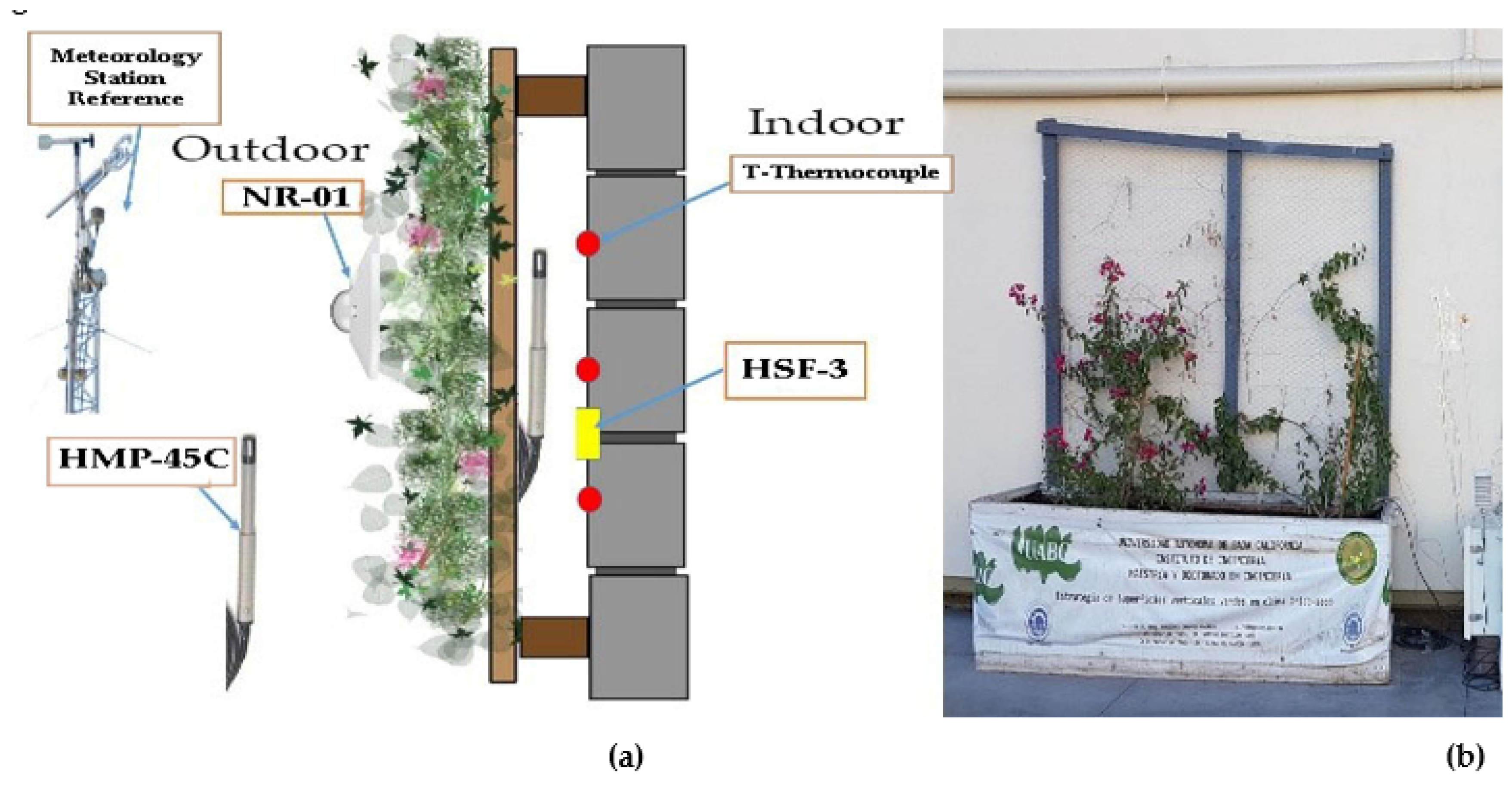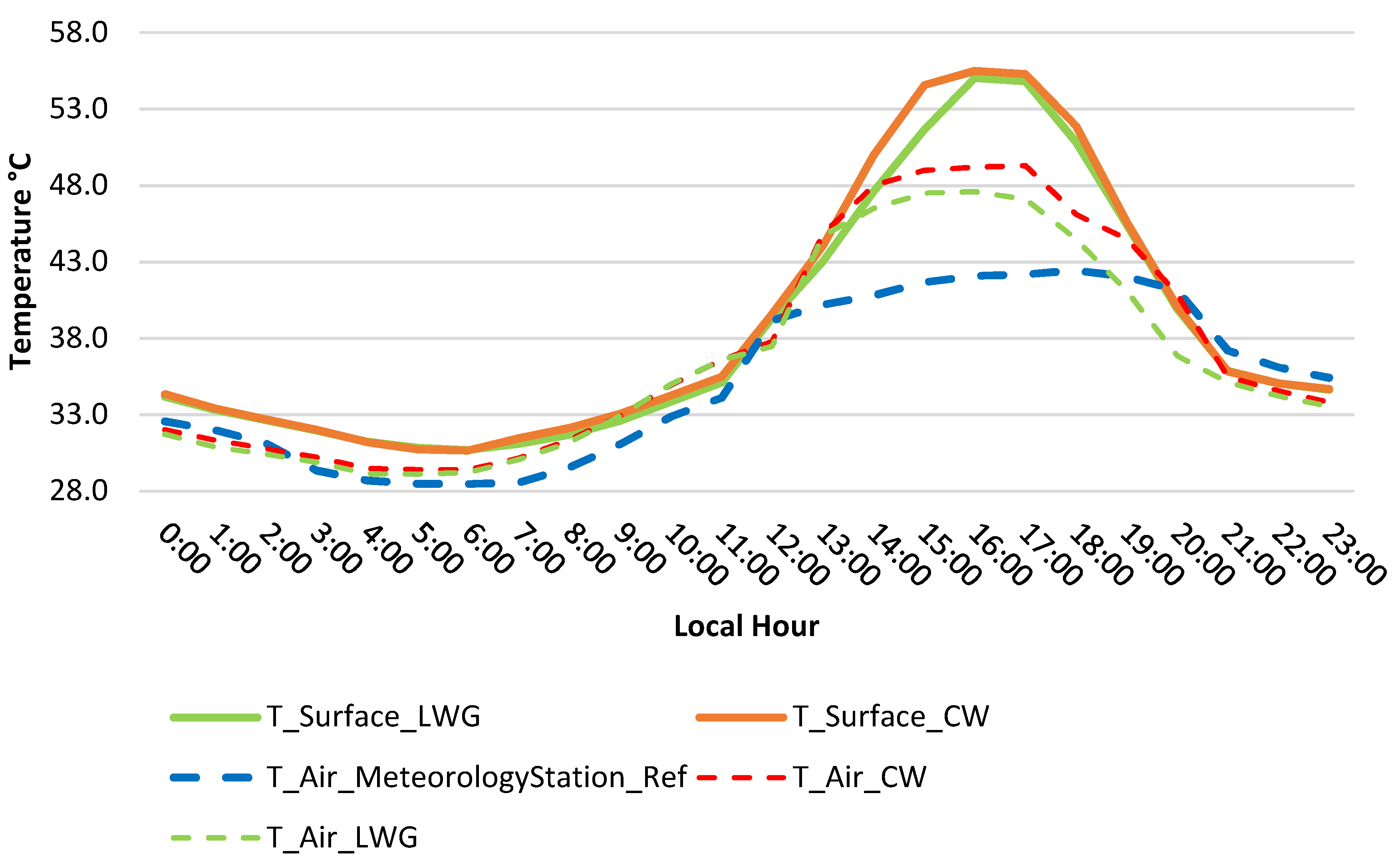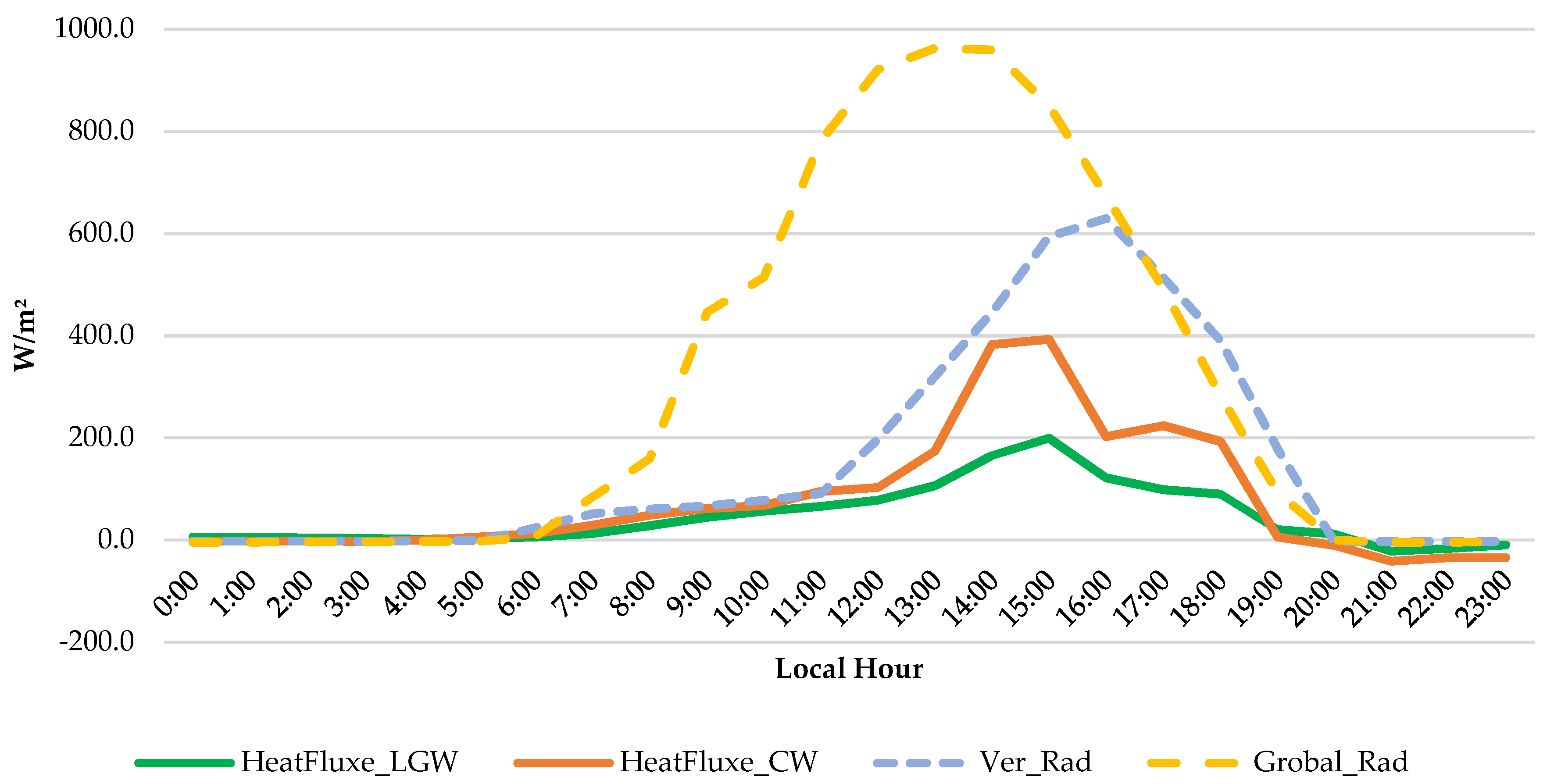Energy and Environmental Comparison between a Concrete Wall with and without a Living Green Wall: A Case Study in Mexicali, Mexico
Abstract
1. Introduction
2. Materials and Methods
2.1. Study Area and Urban Characteristics
2.2. Experimental Design
3. Results and Discussion
Heat Flux and GHG Emissions
4. Conclusions
Author Contributions
Funding
Acknowledgments
Conflicts of Interest
References
- Victorero, F.; Vera, S.; Bustamante, W.; Tori, F.; Bonilla, C.; Gironás, J.; Rojas, V. Experimental Study of the Thermal Performance of Living Walls under Semiarid Climatic Conditions. Energy Procedia 2015, 78, 3416–3421. [Google Scholar] [CrossRef]
- Yang, F.; Yuan, F.; Qian, F.; Zhuang, Z.; Yao, J. Summertime thermal and energy performance of a double-skin green facade: A case study in Shanghai. Sustain. Cities Soc. 2018, 39, 43–51. [Google Scholar] [CrossRef]
- Balchin, W.G.V.; Pye, N. A micro-climatological investigation of bath and the surrounding district. Q. J. R. Meteorol. Soc. 1947, 73, 297–323. [Google Scholar] [CrossRef]
- Stewart, I.D.; Oke, T.R. Local Climate Zones for Urban Temperature Studies. Bull. Am. Meteorol. Soc. 2012, 93, 1879–1900. [Google Scholar] [CrossRef]
- Vox, G.; Blanco, I.; Schettini, E. Green façades to control wall surface temperature in buildings. Build. Environ. 2018, 129, 154–166. [Google Scholar] [CrossRef]
- Haggag, M.; Hassan, A.; Elmasry, S. Experimental study on reduced heat gain through green façades in a high heat load climate. Energy Build. 2014, 82, 668–674. [Google Scholar] [CrossRef]
- Djedjig, R.; Bozonnet, E.; Belarbi, R. Modeling green wall interactions with street canyons for building energy simulation in urban context. Urban Clim. 2016, 16, 75–85. [Google Scholar] [CrossRef]
- Wong, I.; Baldwin, A.N. Investigating the potential of applying vertical green walls to high-rise residential buildings for energy-saving in sub-tropical region. Build. Environ. 2016, 97, 34–39. [Google Scholar] [CrossRef]
- Kolokotroni, M.; Ren, X.; Davies, M.; Mavrogianni, A. London’s urban heat island: Impact on current and future energy consumption in office buildings. Energy Build. 2012, 47, 302–311. [Google Scholar] [CrossRef]
- García-Cueto, R.; Jauregui-Ostos, E.; Toudert, D.; Tejeda-Martínez, A. Detection of urban heat island in Mexicali, B.C. Mexico and its relationship with land use. Atmósfera 2007, 20, 111–131. [Google Scholar]
- Romero, R.A. Vivienda y Consumo de Energía Eléctrica en Zonas Áridas: El caso Mexicali, 1st ed.; Universidad Autónoma de Baja California: Mexicali, México, 2011; p. 141. ISBN 978-607-607-033-8. [Google Scholar]
- Santillán-Soto, N.; García-Cueto, R.; Peñuelas-García, G.; López-Velázquez, J.E.; Ojeda-Benitez, S.; Velázquez-Limón, N.; Cruz-Sotelo, S. Análisis comparativo de emisiones de CO2 y su impacto económico en dos complejos habitacionales de Mexicali, México. In Clima, Sociedad, Riesgos y OrdenaciÓn del Territorio; Universidad de Alicante Servicio de Publicaciones: Alicante, España, 2016; pp. 613–622. [Google Scholar]
- Santillán-Soto, N.; Cueto, O.R.G.; Lambert, A.; Ojeda-Benitez, S.; Cruz-Sotelo, S.E. Comparative Analysis of Two Urban Microclimates: Energy Consumption and Greenhouse Gas Emissions. Sustainability 2019, 11, 2045. [Google Scholar] [CrossRef]
- Perez-Lombard, L.; Ortiz, J.; Pout, C. A review on buildings energy consumption information. Energy Build. 2008, 40, 394–398. [Google Scholar] [CrossRef]
- Banco Mundial BM. Consumo de Energía Eléctrica per Cápita. Available online: https://datos.bancomundial.org/indicador/EG.USE.ELEC.KH.PC (accessed on 8 June 2018).
- Programa de Desarrollo del Sistema Eléctrico Nacional PRODESEN 2018–2032. Secretaría de Energía. pp. 51-60. Available online: https://www.gob.mx/cms/uploads/attachment/file/331770/PRODESEN-2018-2032-definitiva.pdf (accessed on 4 May 2019).
- COPLADE. Programa Especial de Energía 2015–2019. Available online: http://www.copladebc.gob.mx/programas/especiales/Programa%20Especial%20de%20Energia.pdf (accessed on 13 February 2019).
- Suástegui, J.; Perez, C.; Campbell, H.; Magaña, H. Prospectiva del programa de ahorro sistemático integral en Mexicali, Baja California, México. Ingeniería mecánica, tecnológica y desarrollo 2013, 4, 129–134. [Google Scholar]
- Suástegui, J.A. Evaluación del impacto en el consumo eléctrico del programa de ahorro sistemático integral en Mexicali, Baja California. In Tesis de Doctorado en Ingeniería; Universidad Autónoma de Baja California: Mexicali, México, 2020. [Google Scholar]
- Kikegawa, Y.; Genchi, Y.; Kondo, H.; Hanaki, K. Impacts of city-block-scale countermeasures against urban heat-island phenomena upon a building’s energy-consumption for air-conditioning. Appl. Energy 2006, 83, 649–668. [Google Scholar] [CrossRef]
- SEMARNAT. First Biennial Update Report to the United Nation Framework Convention on Climate Change. Available online: https://unfccc.int/files/national_reports/non-annex_i_parties/biennial_update_reports/application/pdf/executive_summary.pdf (accessed on 20 August 2018).
- Rosas-Flores, J.A.; Rosas-Flores, D.; Gálvez, D.M. Saturation, energy consumption, CO2 emission and energy efficiency from urban and rural households appliances in Mexico. Energy Build. 2011, 43, 10–18. [Google Scholar] [CrossRef]
- SEPRIM. Inventario Nacional de Emisiones de GEI. Available online: https://www.gob.mx/cms/uploads/attachment/file/164241/2a_parte.pdf (accessed on 10 April 2018).
- Li, C.; Li, Y.; Zhou, Y.; Shi, Y.; Zhu, X. Investigation of a coupling model of coordination between urbanization and the environment. J. Environ. Manag. 2012, 98, 127–133. [Google Scholar] [CrossRef]
- Susorova, I.; Angulo, M.; Bahrami, P.; Stephens, B. A model of vegetated exterior facades for evaluation of wall thermal performance. Build. Environ. 2013, 67, 1–13. [Google Scholar] [CrossRef]
- Sorensen, M.; Barzetti, V.; Keipi, K.; Williams, J. Manejo de las Áreas Verdes Urbanas. Documento de Buenas Prácticas 1998. Washington, D.C. No. ENV-109. Available online: http://www.sistemamid.com/panel/uploads/biblioteca/2014-09-28_11-36-58111070.pdf (accessed on 23 July 2018).
- Procuraduría Ambiental y de Ordenamiento Territorial PAOT. Available online: http://www.paot.org.mx/contenidos_graficas/delegaciones/detalle.php?id_elemento=11&anio=2016&de_oficio=0&distribucion=3&tema=14 (accessed on 17 November 2019).
- IMIP. Programa de Desarrollo Urbano de Centro de Población de Mexicali, PDUCP 2010-2025. Available online: http://www.mexicali.gob.mx/transparencia/administracion/plandesarrollourbano/pducp2025.pdf (accessed on 27 October 2019).
- CONAPO. Perfil sociodemográfico del municipio de Mexicali. Available online: http://www.copladebc.gob.mx/publicaciones/2018/Mensual/Febrero.pdf (accessed on 28 October 2019).
- Sheweka, S.; Mohamed, N. Green Facades as a New Sustainable Approach towards Climate Change. Energy Procedia 2012, 18, 507–520. [Google Scholar] [CrossRef][Green Version]
- Perini, K.; Paolo, R. Cost–benefit analysis for green façades and living wall systems. Build. Environ. 2013, 70, 110–121. [Google Scholar] [CrossRef]
- Larsen, S.F.; Filippín, C.; Lesino, G. Thermal Simulation of a Double Skin Façade with Plants. Energy Procedia 2014, 57, 1763–1772. [Google Scholar] [CrossRef]
- Perini, K.; Ottelé, M.; Fraaij, A.; Haas, E.; Raiteri, R. Vertical greening systems and the effect on air flow and temperature on the building envelope. Build. Environ. 2011, 46, 2287–2294. [Google Scholar] [CrossRef]
- Virtudes, A.; Manso, M. Green façades: As a feature in urban design. In Proceedings of the ICEUBI 2011, International Conference on Engineering UBI2011, Covilhã, Portugal, 28–30 November 2011. [Google Scholar]
- Silvan, M.M.; Castro-Gomes, J. Thermal analysis of a new modular system for green walls. J. Build. Eng. 2016, 7, 53–62. [Google Scholar]
- Ley, J.; Denigri, M.; García, O.; Venegas, F.; Ochoa, M. Atlas de Riegos del Municipio de Mexicali. 2010. Available online: http://dceg.bajacalifornia.gob.mx/Sasip/documentos/archivos/sid10636282967094206693.pdf (accessed on 26 December 2018).
- Giridhar, G.; Deval, K.; Maheswari, R.; Vasudevan, P. Bougainvillea: A source of energy. Biomass 1985, 7, 241–244. [Google Scholar] [CrossRef]
- Energy Efficient Design of New Building, Except Low-Rise Residential Buildings; ASHRAE. Standard 90.1; American Society of Heating, Refrigerating and Air Conditioning Engineers: Atlanta, GA, USA, 2007.
- Environmental Protection Agency EPA. Greenhouse Gas Equivalencies Calculator. 2019. Available online: https://www.epa.gov/energy/greenhouse-gas-equivalencies-calculator (accessed on 11 November 2019).
- Spilková, J.; Vágner, J. The loss of land devoted to allotment gardening: The context of the contrasting pressures of urban planning, public and private interests in Prague, Czechia. Land Use Policy 2016, 52, 232–239. [Google Scholar] [CrossRef]
- He, Y.; Yu, H.; Ozaki, A.; Dong, N.; Zheng, S. An investigation on the thermal and energy performance of living wall system in Shanghai area. Energy Build. 2017, 140, 324–335. [Google Scholar] [CrossRef]
- Charoenkit, S.; Yiemwattana, S. Living walls and their contribution to improved thermal comfort and carbon emission reduction: A review. Build. Environ. 2016, 105, 82–94. [Google Scholar] [CrossRef]
- Riley, B. The state of the art of living walls: Lessons learned. Build. Environ. 2017, 114, 219–232. [Google Scholar] [CrossRef]



| Model | Parameter | Qty | Unit | Accuracy |
|---|---|---|---|---|
| Temp Probe HMP–45C | Air Temperature | 2 | °C | ±0.05 °C |
| Flux Sensor HSF–3 | Heat Flux | 2 | W/m² | ±0.7 μW |
| Type T Thermocouple | Surface Temperature | 6 | °C | ±0.4 °C |
| NR-01 Net Radiometer | Solar Radiation | 1 | W/m² | ±0.4 W/m² |
| Local Hour | Surface Temperature Site °C | Air Temperature Site °C | Air Temperature Reference Station °C | ||
|---|---|---|---|---|---|
| LGW | CW | LGW | CW | ||
| 13:00 | 43.0 | 44.1 | 44.7 | 44.8 | 40.2 |
| 14:00 | 47.6 | 50.0 | 46.5 | 48.0 | 40.8 |
| 15:00 | 51.6 | 54.6 | 47.5 | 49.0 | 41.7 |
| 16:00 | 55.0 | 55.5 | 47.6 | 49.2 | 42.1 |
| 17:00 | 54.8 | 55.3 | 47.1 | 49.3 | 42.2 |
| 18:00 | 50.8 | 51.9 | 44.5 | 46.1 | 42.4 |
| Average | 50.5 | 51.9 | 46.3 | 47.7 | 41.6 |
| Local Hour | * Global Rad | * Ver Rad | Ver Rad/Global Rad | ** CW | ** LWG | ** CW–LWG in 1 m² | ** CW–LWG in 38 m² | Btu/h | Tons AC | Excess kWh |
|---|---|---|---|---|---|---|---|---|---|---|
| 13:00 | 0.963 | 0.32 | 0.33 | 0.174 | 0.106 | 0.068 | 2.565 | 8752.14 | 0.73 | 1.05 |
| 14:00 | 0.959 | 0.45 | 0.46 | 0.383 | 0.165 | 0.218 | 8.2726 | 28,227.29 | 2.35 | 3.40 |
| 15:00 | 0.851 | 0.59 | 0.70 | 0.392 | 0.199 | 0.193 | 7.3416 | 25,050.58 | 2.09 | 3.02 |
| 16:00 | 0.673 | 0.63 | 0.93 | 0.203 | 0.122 | 0.081 | 3.078 | 10,502.57 | 0.88 | 1.27 |
| 17:00 | 0.492 | 0.51 | 1.04 | 0.223 | 0.098 | 0.126 | 4.769 | 16,272.51 | 1.36 | 1.96 |
| 18:00 | 0.282 | 0.39 | 1.38 | 0.193 | 0.090 | 0.103 | 3.9292 | 13,406.99 | 1.12 | 1.62 |
| --- | --- | --- | Summation: | 1.568 | 0.779 | 0.7883 | 29.96 | 102,212.08 | 8.53 | 12.32 |
| GHG Equivalencies | ||
|---|---|---|
| kWh = Emissions | 985.6 kWh = 697 kg CO2 | 78.4 gallons of gasoline consumed 1704 Miles driven by average passenger vehicle |
| 762 pounds of coal burned | ||
| 0.122 homes‘ electricity use for one year | ||
| 88,872 number of smartphones charged | ||
| 26.5 incadescent lamps switched to light-emitting diodes (LEDs) | ||
| 1.6 barrels of oil consumed 28.5 propane cylinders used for home barbeques |
© 2020 by the authors. Licensee MDPI, Basel, Switzerland. This article is an open access article distributed under the terms and conditions of the Creative Commons Attribution (CC BY) license (http://creativecommons.org/licenses/by/4.0/).
Share and Cite
Campos-Osorio, A.; Santillán-Soto, N.; García-Cueto, O.R.; Lambert-Arista, A.A.; Bojórquez-Morales, G. Energy and Environmental Comparison between a Concrete Wall with and without a Living Green Wall: A Case Study in Mexicali, Mexico. Sustainability 2020, 12, 5265. https://doi.org/10.3390/su12135265
Campos-Osorio A, Santillán-Soto N, García-Cueto OR, Lambert-Arista AA, Bojórquez-Morales G. Energy and Environmental Comparison between a Concrete Wall with and without a Living Green Wall: A Case Study in Mexicali, Mexico. Sustainability. 2020; 12(13):5265. https://doi.org/10.3390/su12135265
Chicago/Turabian StyleCampos-Osorio, Angeles, Néstor Santillán-Soto, O. Rafael García-Cueto, Alejandro A. Lambert-Arista, and Gonzalo Bojórquez-Morales. 2020. "Energy and Environmental Comparison between a Concrete Wall with and without a Living Green Wall: A Case Study in Mexicali, Mexico" Sustainability 12, no. 13: 5265. https://doi.org/10.3390/su12135265
APA StyleCampos-Osorio, A., Santillán-Soto, N., García-Cueto, O. R., Lambert-Arista, A. A., & Bojórquez-Morales, G. (2020). Energy and Environmental Comparison between a Concrete Wall with and without a Living Green Wall: A Case Study in Mexicali, Mexico. Sustainability, 12(13), 5265. https://doi.org/10.3390/su12135265





